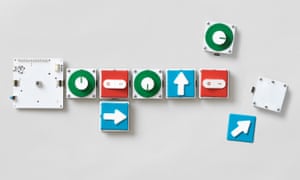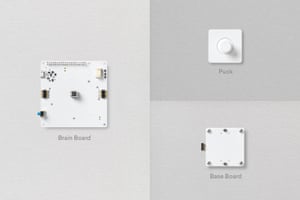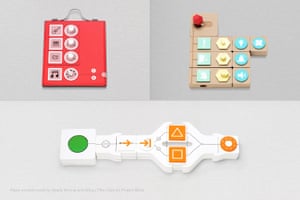
“How many robots can I control with this? In theory, up to 255 at one time. That really is a robot army.”
I’m in a room at Google’s London headquarters listening to creative technologist Zebedee Pedersen show off the company’s latest research project. Despite how it sounds, world domination isn’t on the agenda.
There are only two robots in the room, and right now they’re more concerned with drawing neat triangles on pieces of paper, rather than enslaving humanity.
The pair of Mirobots are demonstrating Project Bloks, Google’s latest attempt to encourage children to learn programming skills. They’re being controlled by a series of plastic blocks, connected by Pederson in a sequence that instructs the robots when to draw, turn and move.
Project Bloks has emerged from a research discipline called “tangible programming” that has been around since the 1970s, aiming to make code physical so that more people – children included – can get to grips with it.
The system consists of three parts. First, a square “brain board” powered by a Raspberry Pi Zero computer, which can connect to other devices – from tablets and robots to speakers and lights – via Bluetooth and Wi-Fi.
Second are the smaller square “base boards”, which connect to one another physically, and relay commands to the brain board from the third element of the system: “pucks”, which slot into the base boards.
Pucks can be flat icons – arrows telling something how to move, for example – or they can be on/off switches, dials or buttons. Each puck represents a single command.
“In the simplest sense, you get a bit of conductive ink and draw a pattern on them, and you’ve just created a new command, so you have to tell the system ‘this command means move’ or something. And the base boards are the conduit to get information from the puck into the brain block, as you assemble your sequences,” says Google creative technologist Joao Wilbert.

Google has already worked with design company IDEO to create a “Coding Kit” using the system, which is being tested with children and schools.
This is all part of the company’s wider efforts around kids and programming, which also include the Blockly visual-programming library; the Made With Codeinitiative aimed at teenage girls, and the CS First summer coding program in the US.
“This is not just about teaching kids how to code: ‘Let’s teach you Java so you can become an engineer.’ It’s about this being a fundamental skill: as fundamental as reading and writing in terms of how to approach problems, and giving kids a language for creative expression,” says Jayme Goldstein, team lead at Google Creative Lab, where Project Bloks was created.
“That’s what spawned the Code.orgs and the Hour of Codes and the Scratches and the Raspberry Pis. Our approach with Google is in line with that others are doing: that kids should be creative with technology, not just consumers of it.”
Google’s blocks (or bloks) aren’t a commercial product, yet. Instead, they’re an architecture for other people to build physical coding kits – from academics wanting to run tangible-programming research projects to startups developing coding toys to sell via Kickstarter.
“It’s about whether we could create an underlying technology to enable researchers, developers and designers to go and make more tangible coding experiences, and push the area forward,” says Goldstein.
That openness is key to the project. The base boards can be made of wood, plastic and other materials, as can the pucks – with potential in the future for people to 3D-print their own components.
“The important thing about these pucks is they are very cheap and easy to make, and you can make them out of any material. A designer might want to make their pucks very high-end out of plastic, or out of wood or 3D-printed parts, or even with paper and foam. There’s a real DIY side to this,” says Wilbert.
It’s early days for this project, which is being announced at the ISTE educational technology conference, before a summer of further tests with children, and then schools. A joint research project and paper with Stanford University will follow.
“There’s an open call to researchers, teachers and developers to be part of this study, and then all the data collected from that survey will be openly available to everyone else in the field to build on top of it,” says Goldstein.
“By putting this out and going public now, we want to get this out in the open. The idea ultimately is to give everything back: we know the power of open platforms.”
“If we’re able to give this tool to people who can they go and create more ideas that use tangible programming, that’s a win for everyone. There is no de facto physical programming grammar that exists. This could help people start to explore what that – or those – might be.”
That means it’s a while before you’ll be able to buy IDEO’s coding kits or other Bloks-based toys online or in shops. Google hasn’t even started the work of “cost-engineering” the pucks, base boards and brain boards to make them as affordable as possible.
In the shorter term, this is about research into the impact tangible programming has on children. “What it’s really good for are collaborative experiences, where you have kids working together. It’s more in tune with how they naturally play: building things, moving around,” says Goldstein.
“It’s great for accessibility design: if you have somebody who is dyslexic, or who doesn’t have their literacy or numeracy skills yet, you can use physical objects, touch and different sensations to help kids understand what’s going on.”
There is also already experimentation around the kind of toys that might be produced. For example, a concept for a programmable music device based on the blocks (top-left below) where each “instrument” can be modified in some way using a dial puck:

The Project Bloks team are sensitive to some of the criticism that may come their way after the announcement. For example, the wider tech industry drive to get children programming has its critics, who worry that it is too much about seeing every child as a potential developer.
Wilbert and Goldstein, unsurprisingly, see things differently. Mirroring the views of other tech companies involved in the kids/coding world, they suggest that this area is as much about other benefits.
“Creative expression is part of this: we wanted to push this as ‘you draw, you create art, you experiment with music’ but you are learning these things [programming skills] as you do it,” says Wilbert.
Goldstein paraphrases Project Bloks partner Paulo Blikstein, from Stanford University, when explaining how he hopes the new system will help children.
“The way he best explained it to me is that with computational thinking, you’re giving kids this language for creative expression,” he says.
“You don’t learn to write to be a professional poet; you don’t learn to read to become a professional Jackanory storyteller; and you don’t learn computational thinking just to become a computer-science engineer. You use it to enrich everything else you’re interested in.”
[Source:- The Guardian]



